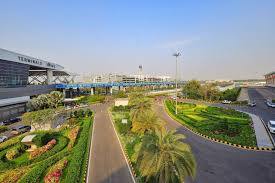
Modern airports function as complex ecosystems, juggling high passenger volumes, stringent security protocols and the need for efficient operations. While functionality remains paramount, a growing focus is being placed on passenger experience. Landscaping emerges as a strategic tool in this effort, influencing aesthetics, passenger well-being and even environmental sustainability. This article explores the considerations of airport landscaping, exploring the challenges, opportunities and best practices for creating welcoming environments.
Airports are often constrained by limited land availability, making it challenging to create expansive green spaces. Additionally, environmental factors such as extreme temperatures, high winds and salt exposure in coastal areas can pose challenges for plant growth and maintenance.
The fluctuating weather conditions characteristic of many regions can impact the health and appearance of landscapes. Extreme heat, frost, heavy rainfall, or drought can stress plants and require specialized care to ensure their survival.
Maintaining airport landscapes involves regular upkeep, including watering, pruning, fertilizing and pest control. Balancing maintenance needs with sustainability goals, such as water conservation and reduced chemical usage, requires careful planning and investment in eco-friendly practices.
Modern airports are increasingly adopting advanced irrigation technologies to optimize water usage and minimize waste. Automated systems with sensors and weather forecasts can adjust watering schedules based on environmental conditions, ensuring efficient irrigation.
Airports can enhance their environmental stewardship by incorporating sustainable practices into landscaping design and maintenance. This includes using treated sewage water for irrigation, implementing green roof systems to mitigate heat island effects and promoting biodiversity through native plantings.
Energy-intensive components of landscaping, such as irrigation pumps, can be made more efficient through the use of Variable Frequency Drive (VFD) systems. These systems adjust motor speed based on demand, reducing energy consumption and operating costs.
Selecting native plant species and drought-resistant varieties can improve resilience to local climate conditions and reduce the need for supplemental irrigation. These plants are adapted to thrive in their native environment, requiring less maintenance and resources.
Advancements in technology, such as remote monitoring systems enable proactive maintenance and surveillance of airport landscapes. These tools provide real-time data on plant health, irrigation efficiency and pest infestations, allowing for timely interventions.
Delhi Airport Terminal 3 (T3) stands as a testament to innovative landscaping practices, setting new standards for airport greenery worldwide. Key features include:
Integration of Smart Technologies: The future of airport landscaping lies in the integration of smart technologies for real-time monitoring, data analytics and predictive maintenance. AI-driven systems can analyze environmental data and user feedback to optimize landscaping strategies and improve passenger satisfaction.
Expansion of Green Infrastructure: Airports are increasingly investing in green infrastructure projects, such as green roofs, vertical gardens and urban forests, to enhance biodiversity and mitigate environmental impacts. These initiatives contribute to climate resilience and create healthier, more sustainable airport environments.
Adoption of Nature-Based Solutions: Nature-based solutions, such as biofiltration swales and constructed wetlands, are gaining traction as cost-effective alternatives to traditional stormwater management practices. These green infrastructure elements improve water quality, reduce flooding risks and enhance aesthetic value.
Collaboration for Sustainable Landscaping Practices: Collaboration between airport authorities, landscape architects, local communities and environmental organizations is essential for promoting sustainable landscaping practices. By sharing knowledge, resources and best practices, stakeholders can collectively work towards creating welcoming and environmentally responsible airport landscapes.
Airport landscapes represent the intersection of nature, technology and human experience, serving as vital components of modern aviation infrastructure. By embracing innovation, sustainability and collaboration, airports can create welcoming environments that delight passengers, support biodiversity and contribute to the overall well-being of surrounding communities. As we look towards the future, let us continue to prioritize sustainable and resilient landscaping practices, ensuring that airports remain vibrant hubs of connectivity and inspiration for generations to come.
If you need any services, drop us a mail at Rohitkumar.Singh@gmrgroup.in or get in touch with us at +919717199753.